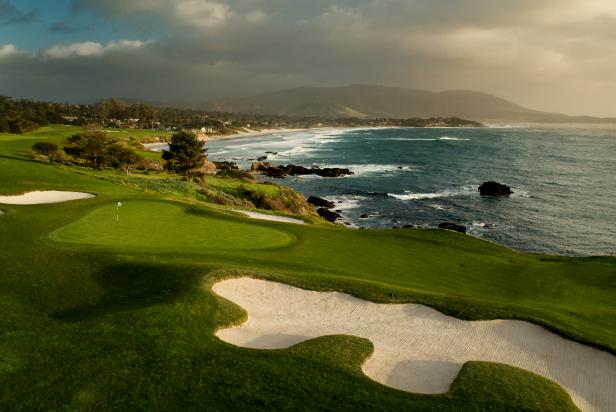One place resides in the central section of a large state surrounded by agriculture, open space and small towns that have seen livelier days. The other is also located in the rural center of a large state, crossed with country roads, power lines and occasional single-story homes. One is a golf resort, hidden in a pocket of overgrown nature, developed in the image of Bandon Dunes. The other, cloaked by hundreds of acres of pine, was developed by the founders of Bandon Dunes. One is built over surprisingly varied ridges of sand and large dunes that not even locals suspect exist. The other . . . you guessed it.
Streamsong, in south-central Florida, and Sand Valley, in Wisconsin, share considerable DNA. Each destination features multiple courses designed by marquee minimalist designers, including one course at each property by Bill Coore and Ben Crenshaw (Streamsong Red, opened in 2012, and Sand Valley, 2017, respectively). But for all the similarities, there are differences that can assist in helping golfers choose where to go—first.
Sand Valley feels like a sleepaway camp for grown-ups with a main rustic lodge made of timber that serves as the nerve center for the resort and cottages spread out along the wooded flanks of the courses. The campus at Streamsong is functionally industrial in concept, with a six-story steel-and-glass hotel that reflects the operations that once took place. Streamsong has four upscale restaurants and a variety of bars offering an international assortment of cuisines, and Sand Valley concentrates the farm-to-table dining energy into the lively Mammoth Bar and adjacent, quieter Aldo’s.
The courses at Streamsong were built atop the spoils of a former phosphate mining operation where incredible quantities of sand were excavated and dumped by machines into large piles. Once the property was mined out, it was abandoned, and over the decades developed an ecosystem of vegetation and wildlife. These dunes, some 50 to 60 feet high, are the foundation of the Red and the Blue Course (designed by Tom Doak’s Renaissance Golf Design) with bump-and-run holes that slither past fearsome bunkers. The Black Course, built by Gil Hanse and Jim Wagner in 2017 on a separate parcel, is perhaps the most flamboyant of the group with some of the world’s largest greens.
Sand Valley is part of an area in Wisconsin that was once a sandy prairie spanning tens of thousands of acres. Pine was planted as a crop, and the forest still obscures the robust topographical movements that make Sand Valley and Mammoth Dunes, designed by David McLay Kidd in 2018, so exciting to play. Both courses are as broad as anything in modern golf, with pine and grassland borders. Coore and Crenshaw built on a more subtle section of the property, but it’s only subtle in comparison to the major demonstrations of Kidd’s course, where holes ride over elevated ridges. Somehow the courses at each resort are easy, economical walks, though carts are popular at Streamsong in the humid summer months.
An added amusement at Sand Valley is The Sandbox, a 17-hole short course/ nature walk that can be played with just a putter, though you’d better be a damn good putter to try it. Not to be outdone, Streamsong announced plans in early 2022 for a short course, designed by Coore and Crenshaw. The big news at Sand Valley is the opening in 2023 of The Lido, a replication of the famous but extinct course C.B. Macdonald began building on Long Island in 1914. Tom Doak and his associates are constructing the course in exact form and scale using computer simulations and GPS modeling. Doak is expected to begin construction of a fourth course at the resort this summer, a 6,000-yard, sub-par 70 design modeled on the old courses of the English heathlands.
All five primary courses reside on America’s Second 100 Greatest Courses as ranked by Golf Digest, and players would be missing something important if they skipped any of them. A random sampling of the best holes would include Streamsong Black’s prodigious par-4 16th that swoops around chasms of sand into a massive, canted green; Streamsong Red’s Francis Bacon meets The Biarritz par-3 16th over water; Streamsong Blue’s mischievous par-4 first playing off the top of a high dune toward a green tucked behind mounds; Sand Valley’s par-5 seventh with a green notched in a hollow and a deep cross bunker camouflaging the best approach angle; and Mammoth Dunes’ par-4 ninth courting risk as it angles diagonally across a wash with perhaps the best green setting at either resort. —DD
Now 103 years old, Pebble Beach Golf Links is No. 1 on Golf Digest’s ranking of America’s 100 Greatest Public Courses and eighth overall among its 100 Greatest Courses list. Since 1972, Pebble Beach has been the site of six U.S. Opens, with winners that include Jack Nicklaus, Tom Watson and Tiger Woods, as well as dozens of other big-time events.
Barely 30 years old and ranked fourth among public courses and 24th overall, the Ocean Course at Kiawah Island saunters with its own swagger for golf lore. Before its first birthday, the Pete Dye creation was the site of the 1991 Ryder Cup, known as the “War by the Shore.” Since then, the Ocean Course has been the site of two unforgettable PGA Championships, with Rory McIlroy and Phil Mickelson lifting the Wanamaker Trophy.
Pebble Beach and Kiawah each abut an ocean, yet neither is a links. Pebble’s Poa annua greens are small and favor aerial darts, not run-ups. Also, with dense ryegrass rough and nine essentially inland holes, the feel at Pebble can be parkland at times, but the ocean is ever-present and permeates the feel of all 18 holes.
All 18 holes at Kiawah’s Ocean course have Atlantic vistas, with 10 that run along the water, yet it seldom plays like a links. This is, after all, the hot and steamy southeast. The grass that thrives tee-to-green is Seashore paspalum, a surface too sticky to permit a links-style ground game.
Pebble Beach is a bucket-list destination. Consequently, there’s a constant hum of tourists eager to gawk at the first tee or 18th green. At the Ocean Course, the isolation-in-nature ambiance is palpable. When it comes to memorable holes, Pebble Beach’s stretch of five through 10 is the most spectacular on Earth, and no walk in golf compares to the stroll up the 18th fairway. The Ocean Course differs in that it has no weak links, but no stretch compares to Pebble Beach’s finest.
Pebble Beach and the Ocean Course aren’t the only attractions at their respective resorts. Pebble Beach’s Spyglass Hill, ranked 10th among U.S. public courses, would be the star virtually anywhere else. Spanish Bay, the 53rd-best U.S. public course, delights with opening and closing holes astride the Pacific. Pebble’s newest treat, The Hay, sports nine par 3s reimagined by Tiger Woods’ TGR Design in 2021.
Kiawah Island Golf Resort’s four other regulation 18s aren’t as highly ranked as Pebble’s offerings; nonetheless they are awfully tasty, especially Tom Fazio’s Osprey Point and Jack Nicklaus’ Turtle Point, which rolls out a trio of oceanside holes.
Pebble Beach provides three lodging options. At the Lodge, rooms are cozy, classically furnished and situated in the heart of the action. Opened in 2017, the two Fairway One Cottages at the Lodge offer up to four bedrooms each, ideal for buddies trips or business confabs. Within the confines of the Pebble Beach complex is Casa Palmero, a villa-style, 24-room resort within a resort. A short shuttle ride from the Lodge is the Inn at Spanish Bay, which sits oceanside in exquisite privacy. It has a more modern, airy ambiance than the Lodge and features outdoor fire pits (ideal for cocktailing) and beach paths.
Kiawah counters with the Sanctuary Hotel, resort villas and private homes. The Sanctuary is a picture of southern graciousness. Its twin-curving staircases off the lobby ooze “Gone With the Wind” noblesse, and the wood-plank flooring and massive picture windows replicate the feel of an old structure.
Dining at Pebble Beach and Kiawah is first-rate. At the Lodge, Stillwater Bar & Grill, the Terrace Lounge and The Bench offer ocean views, but don’t miss the memorabilia-laden Tap Room. The Inn at Spanish Bay delivers with seafood at Roy’s, Tuscan at Peppoli’s, an upscale sports bar at Sticks and single malts at Traps.
At Kiawah, a roster of 14 restaurants and cafes serves up meals and libations. The aptly named Atlantic Room at the Ocean Course (as well as the adjacent Ryder Cup Bar) showcases outstanding views and cuisine. At the Sanctuary Hotel, the Jasmine Porch percolates with a down-home aura and serves delectable regional specialties. —JP
Two clubs, built a quarter century apart, have become avatars of the modern destination club. Sand Hills Golf Club, designed by Bill Coore and Ben Crenshaw in 1995, resides in the seemingly endless Sandhills region of north-central Nebraska. What at first looked like a folly—a lone 18-hole private club without a single tree, hours from any sizable city, barely any facilities and no local pool of players to draw from—became an archetype. Golf romantics from east to west quickly made the long journey to sign on.
The sophisticated Ohoopee Match Club, near Cobbtown in rural southeast Georgia, is the young contender. Designed by Gil Hanse and Jim Wagner in 2019, it’s more like Sand Hills 2.0, a next-generation take on Sand Hills’ rugged golf individualism but with a more refined standard of leisure. These two clubs—and others like them—represent the pinnacle of what the adventurous player wants in a golf club: a retreat, a change, maximum stimulation and a sense of total golf immersion.
Nebraska’s Sandhills and the south Georgia outback would be the last places yesterday’s titans of industry would expect to be playing golf. But today’s titans know that where there is sand, there is potential. The Sandhills region comprises almost 20,000 square miles of dunes that once were ocean—no better foundation for links-style golf. Ohoopee is in a rural woodland of scrub oak and pine, but its land used to be ocean—it’s just south of what’s known as the Fall Line in Georgia demarking the division between former sea bottom and the heavy soils of the ancient continent.
Each club has a distinct character. Like the ranch culture that gives it life, Sand Hills is friendly yet austere. Its 160 members love pure golf and need no pampering. They typically fly into North Platte and make the hour trek north. Most everyone visiting Sand Hills plays an early 18, grabs a beer and a grilled burger or dog at the small lunch spot overlooking the ninth green called Ben’s Porch, then heads out for another 18. Then it’s a shower and off to drinks and dinner. Ohoopee’s undisclosed number of national members are used to something similar yet more upscale. Those with private planes land at Vidalia Regional Airport 25 minutes away, and others come into Savannah, 60 minutes in the other direction. On arrival, members enjoy a chef-made lunch and a quick warmup, then it’s off to the course with caddies on the regulation 18-hole routing or the shorter, alternate “Whiskey Loop” that incorporates four extra holes and is named for the bourbon stashed on each tee box. For member-sponsored guests, everything is included in the fee and several well-stocked comfort stations positioned throughout the layout leave players wanting for nothing. Dinners are lively, and the brick patio with fire pits near the 18th hole and putting green is the place to wind down the night.
Sand Hills bounces along crisp turf over an eternal roll of open, grass-covered dunes marked with bunkers scarred by the wind and chunked around the edges. The greens are essentially expressions of the wild formations that naturally occur in the land beneath, and the constant turns of direction and up-and-down elevations create stunning variety. In the wind and hot summer sun, the course can be a beast. Ohoopee is a gentler voyage through nature, though also warm. The majestic breadth of the fairways invites aggressive driving, and most holes play through individual pockets of wood except for the portion of the layout that borders a broad pasture where wildlife, including zebras, graze. The greens, ranging from enormous to dainty, possess outrageous contours, and the length and par of the holes are irrelevant because every round is intended to be played as a match.
The word that best describes Sand Hills is focused. The guest cabins are closer to Residence Inn than Ritz Carlton, though they have been upgraded in recent years.
The main building looks as much like a modest, single-story home as a clubhouse. But that’s part of the charm. After golf, members and guests meet in the bar for Moscow Mules or other stiff drinks, then retire upstairs to the nameless restaurant where entire tables are likely to order the Tuscan grilled strip steak. Ohoopee members and guests stay in cottages or in single rooms in the main lodge, a low-slung three-story structure of brick, wood and glass. The restaurant serves Michelin-star quality cuisine, and the drink of choice is usually Woodford Reserve, which makes two special bottlings of its bourbon for the club. It helps everyone sleep peacefully, so they can get up and do it all again in the morning. —DD
Ranked 64th on America’s 100 Greatest Public Courses by Golf Digest, the Dunes Golf & Beach Club in Myrtle Beach is a 1948 Robert Trent Jones Sr. creation. Unforgettable is the 640-yard, par-5 13th “Waterloo” that doglegs 110 degrees to the right around alligator-strewn Lake Singleton.
Drenched in Lowcountry charm, Caledonia Golf & Fish Club delights with a short, tight layout that’s replete with lakes, wetlands and fairways framed by live oaks. Ranked 85th among the 100 Greatest Public Courses, this 1994 design by Mike Strantz closes with a par 4 that edges the Waccamaw River, with a green backdropped by an antebellum clubhouse.
More than 30 years after its debut, Shadow Creek in Las Vegas remains an oasis of pine trees, rolling hills, flowers and waterfalls hewn from a poker-table-flat desert floor by magicians Tom Fazio and Steve Wynn. Ranked as the fifth-best public course in the United States and No. 27 overall by Golf Digest, seldom-seen Shadow Creek finally peeled back its curtain, hosting The Match in 2018 that pitted Tiger Woods against Phil Mickelson.
In 2000, Rees Jones delivered Cascata, his version of a desert links. Draped dramatically across stark mountain slopes, the course plays firm and fast, with run-up approaches often the proper play. Stray tee shots will find the rocks—and perhaps a bighorn sheep.
Myrtle Beach is the supermarket of golf. With nearly 100 options, there’s no destination that serves up so many solid trophy, second-and third-tier courses, virtually all of them public. Among the many stalwarts in the region are Mike Strantz’ True Blue; Barefoot Resort’s four courses, crafted by Pete Dye, Tom Fazio, Greg Norman and Davis Love III; Tidewater; and Tom Fazio’s TPC Myrtle Beach.
Las Vegas is home to nearly 60 courses, the majority of them high-end public tracks. The winner for best public-access course on the Strip is Wynn Golf Club, another Fazio creation that’s packed with mature trees and dazzling water features. Off the Strip, Jack Nicklaus’ Reflection Bay, Rees Jones’ Rio Secco and all three Pete Dye courses at Las Vegas Paiute Resort are consensus top picks.
Myrtle Beach deserves its billing as America’s golf vacation capital. Myriad packages that combine golf and lodging maximize value for visitors, with nearly every course participating. Most of the Grand Strand courses are flat or mildly undulating and are invariably sprinkled with lakes, wetlands and modern design features. Winter calls for an extra layer, and summers will make you sweat, but most years, you can tee it up all 365.
December desert days can be chilly in Las Vegas—but don your quarter zip and play all winter. Summer days can climb to 110 degrees, albeit with low humidity. As with Myrtle Beach, spring and fall temperatures are ideal. While a few of the older tracks are wall-to-wall grass, most Vegas courses are target-style, or else have desert accents or backdrops. Vegas golf is pricey, but as PGA Tour player Charley Hoffman (an area resident) puts it, “At least golf keeps you busy for five hours.”
The Grand Strand of Myrtle Beach coastline stretches 60 miles and into two states. Drive time can cut into golf time. If you’re planning a 36-hole day, book side-by-side courses, or at least two that are proximate.
Las Vegas’ most appealing courses are spread in every direction, with some as much as a 45-minute drive from the Strip. Taxi or ride shares are cheap from the airport to your Strip hotel, but taxing on a budget if you’re playing multiple rounds. Avoid Las Vegas Boulevard at any time and steer clear of the major freeways during rush hour.
You can still find deep-fried food, pancake houses and mini-golf on almost every Myrtle Beach intersection, but there’s so much more these days, if predominantly family-oriented. Broadway at the Beach and Barefoot Landing are two experiences that offer multiple dining/entertainment options, including Topgolf and minor league baseball.
As for Las Vegas? Anything you can contemplate dining on or doing is here, except swimming in an ocean. —JP










